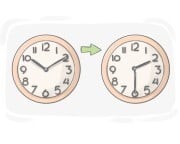Erweiterter Wortschatz für den TOEFL - Zeit und Raum
Hier lernen Sie einige englische Wörter über Zeit und Raum, wie "abnehmen", "Zwerg", "Nebel" usw., die für die TOEFL-Prüfung benötigt werden.
Überprüfen
Lernkarten
Rechtschreibung
Quiz


Epoche
Für den Wissenschaftler markierte die Entdeckung des neuen Elements den Beginn einer revolutionären Epoche in der Chemie.

abnehmen
Im Laufe des Monats wird der Mond jede Nacht abnehmen.

zunehmen
Als die Tage vergingen, wuchs der Mond und offenbarte seine strahlende Schönheit den Sternenguckern.

vergehen
Die Frist für das Projekt verstrich, bevor sie es fertigstellen konnten.

Dämmerung
Sie genossen einen romantischen Spaziergang am Strand während der ruhigen Stunden der Dämmerung.

Raumzeit
Das Konzept der Raumzeit vereinigt die drei Dimensionen des Raums mit der vierten Dimension der Zeit zu einem einzigen vierdimensionalen Kontinuum.

Sternschnuppe
Sie hat sich etwas gewünscht, als die Sternschnuppe über den Himmel zog.

Zwerg
Braune Zwerge sind substellare Objekte, die zu groß sind, um als Planeten betrachtet zu werden, aber zu klein, um die Wasserstofffusion aufrechtzuerhalten.

Nebel
Ein Nebel entsteht, wenn ein Stern explodiert oder seine äußeren Schichten abstößt.

Meteoroid
Meteoroide stammen oft von Kometen oder Asteroiden und können in der Größe von winzigen Partikeln bis zu Objekten mit einem Durchmesser von mehreren Metern reichen.

Astrophysik
Fortschritte in der Astrophysik haben tiefere Einblicke in die Natur von Schwarzen Löchern und das Verhalten von Materie unter extremen Bedingungen geliefert.

Astrobiologie
Wissenschaftler, die in der Astrobiologie forschen, untersuchen die Bedingungen, die notwendig sind, damit Leben auf anderen Planeten gedeihen kann.

Nordlicht
Das Nordlicht wird durch geladene Teilchen des Sonnenwinds verursacht, die mit dem Magnetfeld und der Atmosphäre der Erde interagieren.

Südlicht
Wie sein nördliches Gegenstück, das Nordlicht, wird das Südlicht durch geladene Teilchen des Sonnenwinds verursacht, die mit Gasen in der Erdatmosphäre kollidieren.

Greenwich Mean Time
Er stellte seine Uhr auf Greenwich Mean Time für den internationalen Anruf ein.

ewig
Sie genossen die ewige Schönheit des immergrünen Waldes.

Exoplanet
Die Suche nach bewohnbaren Exoplaneten ist ein zentraler Schwerpunkt bei der Suche nach außerirdischem Leben.

Vollmond
Fotografen versammelten sich, um die Schönheit der Landschaft im Schein des Vollmonds einzufangen.

Ewigkeit
Das alte Haus war seit Äonen nicht mehr aktualisiert worden.

Tierkreis
Die genaue Beobachtung der Position der Sterne innerhalb des Tierkreises war entscheidend für frühe Astronomen, um astrologische Ideen zu entwickeln.






